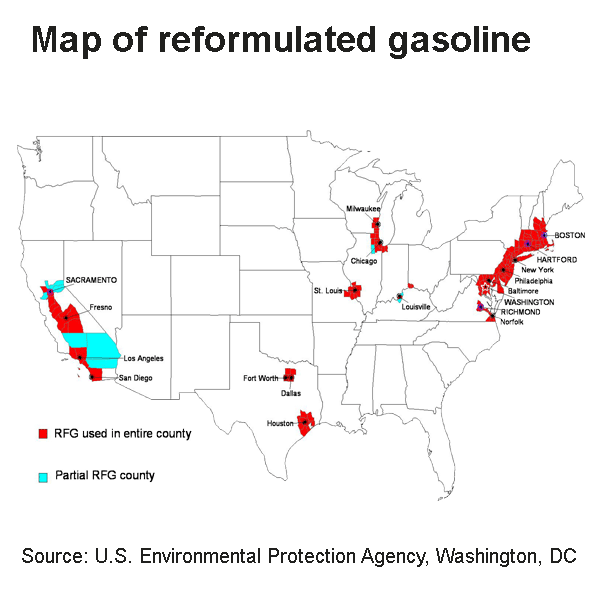Gasoline consumption contributes to air pollution
Gasoline is a toxic and highly flammable liquid. The vapors given off when gasoline evaporates and the substances produced when gasoline is burned (carbon monoxide, nitrogen oxides, particulate matter, and unburned hydrocarbons) contribute to air pollution. Burning gasoline also produces carbon dioxide, a greenhouse gas.
Laws like the Clean Air Act reduce environmental effects
Most consumers use gasoline in cars, light trucks, and motorcycles, but it is also used in small aircraft, boats and other watercraft, and landscaping and construction equipment. Some U.S. environmental laws focus on reducing pollution from these sources.
The Clean Air Act (the Act) seeks to reduce air pollution in the United States. Specifically, the Act (first passed in 1970) and its amendments require engines and fuels to produce less air pollution—among other requirements.1 To meet the air pollution reduction goals of the Act, the U.S. Environmental Protection Agency (EPA) took several actions to reduce pollution from gasoline use:
- Required emissions-control devices and cleaner burning engines
Emissions-control devices on passenger vehicles were required beginning in 1976. In the 1990s, the EPA established emissions standards for other types of vehicles and for engines in gasoline-burning, non-road equipment.2 - Banned leaded gasoline for vehicles
Lead in gasoline proved to be a public health concern. The move away from leaded gasoline began in 1976, when catalytic converters were installed in new vehicles to reduce the emissions of toxic air pollutants. Vehicles equipped with a catalytic converter cannot operate on leaded gasoline because the presence of lead in the fuel damages the catalytic converter. Leaded gasoline for vehicles was completely phased out of the U.S. fuel system by 1996. Leaded aviation gasoline is allowed for piston-engine aircraft. The U.S. government is supporting research on alternative, lead-free fuels for those types of aircraft.3 - Required reformulated gasoline
Beginning in 1995, the Clean Air Act Amendments of 1990 required cleaner-burning reformulated gasoline to reduce air pollution in metropolitan areas that had significant ground-level ozone pollution.4 - Required ultra-low sulfur gasoline
As of January 1, 2017, refiners are required to supply gasoline with 97% less sulfur content than the gasoline made in 2004. Gasoline with lower sulfur content reduces emissions from old and new vehicles and is necessary for advanced vehicle emission-control devices to work properly.5 - Reduced gasoline leaks
Gasoline leaks happen at gas stations every day. As people fill up their gas tanks, gasoline drips from the nozzle onto the ground and vapors leak from open gas tanks into the air. Gasoline leaks can also happen in pipelines or in underground storage tanks, where they can't be seen. Beginning in 1990, all underground storage tanks had to be replaced by tanks with double lining. The double lining provides an additional safeguard for preventing leaks.6
Methyl tertiary butyl ether (MTBE), one of the chemicals added to gasoline to help it burn cleaner, is toxic, and a number of states started banning the use of MTBE in gasoline in the late 1990s. By 2007, the U.S. refining industry had voluntarily stopped using MTBE when making reformulated gasoline for sale in the United States. MTBE was replaced with ethanol, which is not toxic.7
1 U.S. Environmental Protection Agency, Transportation: Mobile Sources.
2 U.S. Environmental Protection Agency, Nonroad Engines, Equipment, and Vehicles.
3 U.S. Federal Aviation Administration, Aviation Gasoline.
4 U.S. Environmental Protection Agency, Reformulated gasoline
5 U.S. Environmental Protection Agency, Gasoline sulfur
6 U.S. Environmental Protection Agency, Underground Storage Tanks.
7 U.S. Environmental Protection Agency, MTBE in Fuels
Last updated: April 16, 2024.

